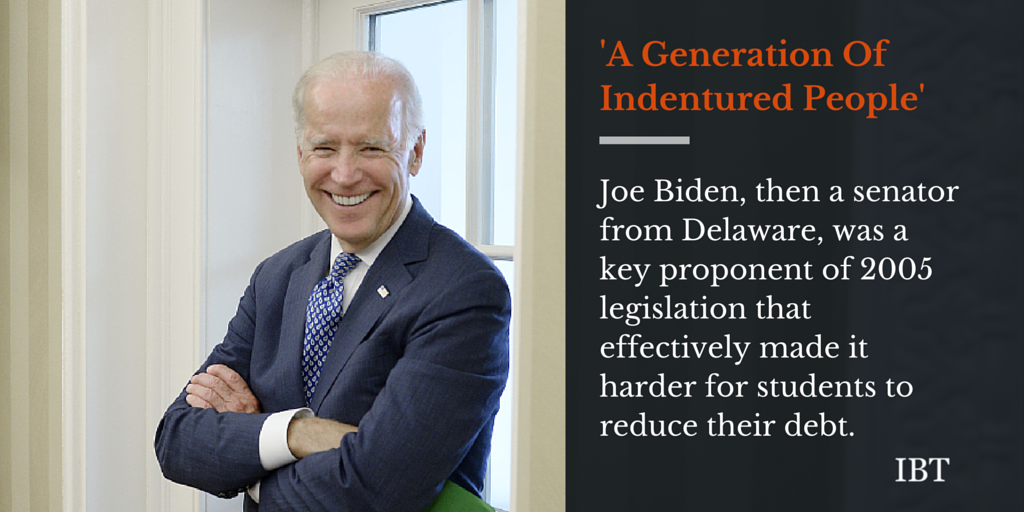Jennifer
Ryan did not love the idea of taking on debt, but she figured she was investing
in her future. Eager to further her teaching career, she took out loans to gain
certification and later pursued an advanced degree. But her studies came at a
massive cost, leaving her confronting $192,000 in student loan debt.
“It’s
overwhelming,” Ryan told International Business Times of her debts. “I can’t
pay it back on the schedule the lenders have demanded.”
In
recent months, Democrats have touted legislation to roll back that law, as
Americans now face more than $1.2 trillion in total outstanding debt from their
government and private student loans. The bill is a crucial component of the
party’s pro-middle-class economic message heading into 2016.
Yet one of the
lawmakers most responsible for limiting the legal options of Ryan and students
like her is the man who some Democrats hope will be their party’s
standard-bearer in 2016: Vice President Joe Biden.
As
a senator from Delaware — a corporate tax haven where the financial industry is
one of the state’s largest employers — Biden was one of the key proponents of
the 2005 legislation that is now bearing down on students like Ryan.
That bill
effectively prevents the $150 billion worth of private student debt from being
discharged, rescheduled or renegotiated as other debt can be in bankruptcy
court.
Biden’s
efforts in 2005 were no anomaly. Though the vice president has long portrayed
himself as a champion of the struggling middle class — a man who famously
commutes on Amtrak and mixes enthusiastically with blue-collar workers — the
Delaware lawmaker has played a consistent and pivotal role in the financial
industry’s four-decade campaign to make it harder for students to shield
themselves and their families from creditors, according to an IBT review of
bankruptcy legislation going back to the 1970s.
Biden’s
political fortunes rose in tandem with the financial industry’s. At 29, he won
the first of seven elections to the U.S. Senate, rising to chairman of the
powerful Judiciary Committee, which vets bankruptcy legislation.
On that
committee, Biden helped lenders make it more difficult for Americans to reduce
debt through bankruptcy — a trend that experts say encouraged banks to loan
more freely with less fear that courts could erase their customers’ repayment
obligations.
At the same time, with more debtors barred from bankruptcy
protections, the average American’s debt load went up by two-thirds over the last
40 years. Today, there is more than $10,000 of personal debt for every person
in the country, as compared to roughly $6,000 in the early 1970s.
That
increase — and its attendant interest payments — have generated huge profits
for a financial industry that delivered more than $1.9 million of campaign
contributions to Biden over his career, according to data compiled by the
Center for Responsive Politics.
Student
debt, which grew as Biden climbed the Senate ladder and helped lenders tighten
bankruptcy laws, spiked from $24 billion issued annually in 1990-91 to $110
billion in 2012-13, according to data from the Pew Research Center.
According
to the Institute for College Access and Success, as of 2012, roughly one-fifth
of recent graduates’ student debt was from private loans that “are typically
more costly” than government loans.
Consequently,
every major Democratic presidential candidate has introduced his or her own
plan to reduce college debt. Biden himself has spotlighted the issue as he has
publicly pondered a White House bid.
Earlier this month he attended an event to
discuss student debt at community colleges, telling students at Miami-Dade
College: “I doubt there were many of you who could sit down and write a check
for $6,000 in tuition without worrying about it.”
His comments amplified his
rhetoric from the 2012 election, when he decried the fact that “two-thirds of
all the students who attend college take out loans to pay for school.” He said
that the accumulated debt means that when the typical student graduates, “you
get a diploma and you get stapled to it a $25,000 bill.”
But
advocates for stronger protections for debtors argue that Biden was a driving
force in creating the laws that made the problem worse.
“Joe
Biden bears a large amount of responsibility for passage of the bankruptcy
bill,” Ed Boltz, president of the National Association of Consumer Bankruptcy
Attorneys, said in an interview with IBT.
That
legislation created a crisis, said Northeastern University law professor Daniel
Austin. Federal Reserve data show that about 1.1 million people face student
debt loans of $100,000 or more, and roughly 167,000 face student loans of
$200,000 or more.
